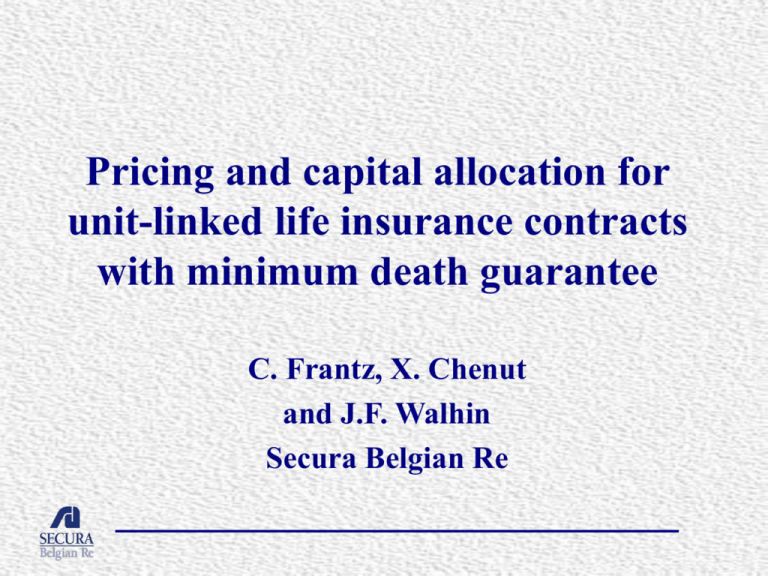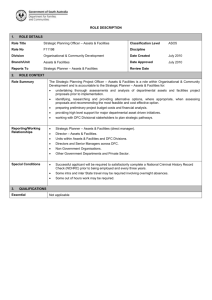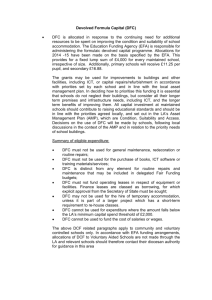Presentation
advertisement

Pricing and capital allocation for unit-linked life insurance contracts with minimum death guarantee C. Frantz, X. Chenut and J.F. Walhin Secura Belgian Re The problem Capital sous risque dans une garantie plancher Sum at risk Insurer’s liability for a death at time t: Valeur de l'UC 1,2 max( K , St ) St max( K St ,0) 1 0,8 0 1 2 3 4 5 Années Time t • How to price it ? • Capital allocation ? 6 7 8 9 10 Two approaches … The financer: it is a contingent claim Solution: hedging on the financial market Black-Scholes put pricing formula The actuary: it is an insurance contract Solution: equivalence principle Expected value of future losses … and two risk managements Financial approach : hedging on financial markets Actuarial approach : reserving and raising capital Agenda Actuarial vs financial pricing Monte Carlo simulations Cash flow model Open questions First question: actuarial or financial pricing? Hypotheses : – Complete and arbitrage-free financial market – Constant risk-free interest rate – Financial index follows a GBM: dS t S t dt S t dWt Simple expressions for the single pure premium in both approaches Single pure premiums T Actuarial pricing : SPP Act Ke rk ( d 2Act (0, k )) k p x q x k k 1 T S 0 e ( r ) k ( d1Act (0, k )) k p x q x k k 1 T Financial pricing : SPP Ke rk (d 2Fi (0, k )) k p x q x k Fi k 1 T S 0 (d1Fi (0, k )) k p x q x k k 1 with log( St / K ) ( 2 / 2)(T t ) Act d 2 (t , T ) T t Act 1 d (t , T ) d Act 2 (t , T ) T t log( St / K ) (r 2 / 2)(T t ) d (t , T ) T t Fi 2 d1Fi (t , T ) d 2Fi (t , T ) T t Monte Carlo simulations Goal : distribution of the future costs 3 processes to simulate : – Financial index – Death process – Hedging strategy (financial approach only) Probability distribution functions 1 0,8 0,6 0,4 0,2 Actuarial Financial 0 0 10 20 30 Discounted future costs 40 50 60 Sensitivity analysis Distribution of DFCAct - variation of 1,00 20% 15% 0,80 10% 8,5% 5% 0,60 0% -5% -10% 0,40 -15% -20% No Stock 0,20 0,00 0 10 20 30 40 Act DFC 50 60 70 80 Sensitivity analysis Distribution of DFC Fi - variation of - 1 0,8 0,6 FI -10% 0,4 -5% 0% 5% 8,50% 0,2 10% 15% 20% 0 6 7 8 9 10 DFC Fi 11 12 13 14 Conclusion Financial approach is better BUT only makes sense if the hedging strategy is applied ! Difficult to put into practice (especially for the reinsurer) Conclusion : actuarial approach has to be used Second question : How to fix the price ? Base : single pure premium + Loading for « risk » Answer : cash flow model Cash flow model Insurance contract = investment by the shareholders Investment decision: cash flow model t 1 2 5 … P Ct Rt Kt rt(R) rt(K) Taxes Price P fixed according to the NPV criterion Open questions How much capital to allocate? How to release it through time? What is the cost of capital? Risk measures and capital allocation Coherent risk measures (Artzner et al.) Conditional tail expectation (CTE): CTE ( X ) [ X X V ( X )] where Vα ( X ) inf V : X V Capital to be allocated at time t: k t CTE ( DFCt ) pt One-period vs multiperiodic risk measures Problem: intermediate actions during development of risk Addressed recently by Artzner et al. Capital at time t : – to cover all the discounted future losses? – to pay the losses for x years and set up provisions at the end of the period? We applied the one-period risk measure to the distribution of future losses at each time t Simulation of provisions and capital Two possibilities: – Independent trajectories Independent trajectories P(t) K(t) t=1 Simulation of provisions and capital Two possibilities: – Independent trajectories P(t ) EDFC (t ) K (t ) P(t ) EDFC (t ) DFC (t ) V ( DFC (t )) – Tree simulations Tree simulations N P1(t) K1(t) P(t ) P (t ) i 1 i N N PN(t) KN(t) t=1 K (t ) K (t ) i i 1 N Simulation of provisions and capital Two possibilities: – Independent trajectories P(t ) EDFC (t ) K (t ) P(t ) EDFC (t ) DFC (t ) V ( DFC (t )) – Tree simulations P(t ) E E DFC (t ) St , N t EDFC (t ), K (t ) P(t ) E E DFC (t ) DFC (t ) V ( DFC (t )), St , N t E DFC (t ) DFC (t ) V ( DFC (t )) . Cost of capital CAPM : COC r b (rm r ) What is the b for this contract? – Same b for the whole company? – Specific b for this line of business? How to estimate it? Conclusions Actuarial approach Pricing and capital allocation using simulations Other questions: – Asset model: GBM, regime switching models, (G)ARCH, Jump diffusion, …? – Risk measure? Threshold ? – Capital allocation and release through time?




